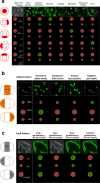Next-Generation Autoantibody Testing by Combination of Screening and Confirmation-the CytoBead® Technology
- PMID: 27368807
- PMCID: PMC5502073
- DOI: 10.1007/s12016-016-8574-3
Next-Generation Autoantibody Testing by Combination of Screening and Confirmation-the CytoBead® Technology
Abstract
Occurrence of autoantibodies (autoAbs) is a hallmark of autoimmune diseases, and the analysis thereof is an essential part in the diagnosis of organ-specific autoimmune and systemic autoimmune rheumatic diseases (SARD), especially connective tissue diseases (CTDs). Due to the appearance of autoAb profiles in SARD patients and the complexity of the corresponding serological diagnosis, different diagnostic strategies have been suggested for appropriate autoAb testing. Thus, evolving assay techniques and the continuous discovery of novel autoantigens have greatly influenced the development of these strategies. Antinuclear antibody (ANA) analysis by indirect immunofluorescence (IIF) on tissue and later cellular substrates was one of the first tests introduced into clinical routine and is still an indispensable tool for CTD serology. Thus, screening for ANA by IIF is recommended to be followed by confirmatory testing of positive findings employing different assay techniques. Given the continuous growth in the demand for autoAb testing, IIF has been challenged as the standard method for ANA and other autoAb analyses due to lacking automation, standardization, modern data management, and human bias in IIF pattern interpretation. To address these limitations of autoAb testing, the CytoBead® technique has been introduced recently which enables automated interpretation of cell-based IIF and quantitative autoAb multiplexing by addressable microbead immunoassays in one reaction environment. Thus, autoAb screening and confirmatory testing can be combined for the first time. The present review discusses the history of autoAb assay techniques in this context and gives an overview and outlook of the recent progress in emerging technologies.
Keywords: Autoimmune disease; Digital fluorescence; Indirect immunofluorescence; Multiplex diagnostics; Second-generation autoantibody testing.
Figures



Similar articles
-
CytoBead ANA 2 assay - a novel method for the detection of antinuclear antibodies.Sci Rep. 2025 Jul 1;15(1):22131. doi: 10.1038/s41598-025-04583-3. Sci Rep. 2025. PMID: 40594218 Free PMC article.
-
New platform technology for comprehensive serological diagnostics of autoimmune diseases.Clin Dev Immunol. 2012;2012:284740. doi: 10.1155/2012/284740. Epub 2012 Dec 19. Clin Dev Immunol. 2012. PMID: 23316252 Free PMC article. Review.
-
Second generation analysis of antinuclear antibody (ANA) by combination of screening and confirmatory testing.Clin Chem Lab Med. 2015 Nov;53(12):1991-2002. doi: 10.1515/cclm-2015-0083. Clin Chem Lab Med. 2015. PMID: 26020561
-
Comparison of the analytical and clinical performances of two different routine testing protocols for antinuclear antibody screening.J Clin Lab Anal. 2021 Sep;35(9):e23914. doi: 10.1002/jcla.23914. Epub 2021 Aug 4. J Clin Lab Anal. 2021. PMID: 34347308 Free PMC article.
-
The clinical significance of the dense fine speckled immunofluorescence pattern on HEp-2 cells for the diagnosis of systemic autoimmune diseases.Clin Dev Immunol. 2012;2012:494356. doi: 10.1155/2012/494356. Epub 2012 Dec 6. Clin Dev Immunol. 2012. PMID: 23304189 Free PMC article. Review.
Cited by
-
Reliability and reproducibility of antinuclear antibody testing in pediatric rheumatology practice.Front Med (Lausanne). 2023 Jan 9;9:1071115. doi: 10.3389/fmed.2022.1071115. eCollection 2022. Front Med (Lausanne). 2023. PMID: 36714114 Free PMC article. Review.
-
CytoBead ANA 2 assay - a novel method for the detection of antinuclear antibodies.Sci Rep. 2025 Jul 1;15(1):22131. doi: 10.1038/s41598-025-04583-3. Sci Rep. 2025. PMID: 40594218 Free PMC article.
-
Efficiency scale for scattering luminescent particles linked to fundamental and measurable spectroscopic properties.Sci Rep. 2023 Apr 17;13(1):6254. doi: 10.1038/s41598-023-32933-6. Sci Rep. 2023. PMID: 37069220 Free PMC article.
-
Autoimmunity in 2017.Clin Rev Allergy Immunol. 2018 Dec;55(3):239-253. doi: 10.1007/s12016-018-8699-7. Clin Rev Allergy Immunol. 2018. PMID: 30051260 Review.
References
Publication types
MeSH terms
Substances
LinkOut - more resources
Full Text Sources
Other Literature Sources

